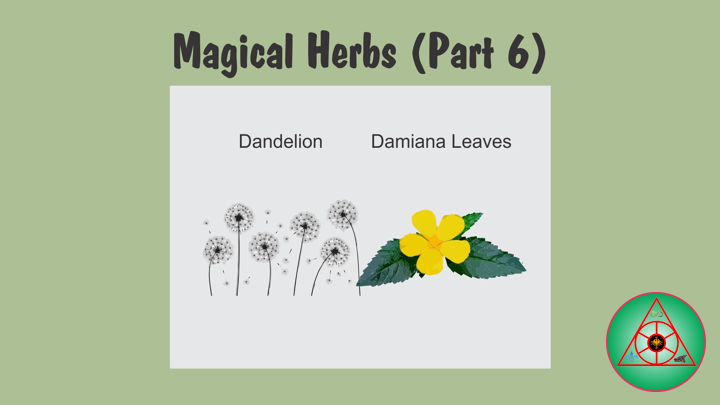——
Magic #TLBWB #HighPriest #Witchcraft #Wizard #Witch #BookOfShadows #WheelOfTheYear #MagicalHerbs #Dandelion #Damiana #MagicalOils #Incense #Pentacle #MagicCircle #Spell #Grimoires
——
——
Magical Herbs
So, let’s talk magical herbs. Whether you think of them as mysterious plants that grow in the forest or the row of little bottles in your kitchen cabinet, they’re pretty useful, and they can be pretty confusing, even intimidating. What do you do with them? Which ones do I need? These herbs will help you with almost any need or problem you may have, as we shall explain. If you’re a practitioner of a modern magical tradition, chances are good that you’re in the habit of using herbs. Here’s a list of herbs that everyone should have on hand for magical purposes. Think of it as a basic Wizard or Witch’s arsenal of helpful herbs. Keep a few of these in your magical supply cabinet, just in case the need arises.
Once you have acquired your supply of herbs, we have a few suggestions regarding storage. Herbs are best kept in a cool, dry, dark location to maximize their lifespan. Excessive heat and moisture can cause them to become moldy, and prolonged strong sunlight can dry out and fade them. Specific methods of storage are up to you. Keep them in their plastic bags, stored in a cabinet. Transfer them to attractive glass jars with fancy ornamental stoppers. Whatever makes you feel magical and keeps your herbs fresh and easily accessible is fine.
Dandelion
Taraxacum is a large genus of flowering plants in the family Asteraceae, which consists of species commonly known as dandelions. The scientific and hobby study of the genus is known as taraxacology. The genus is native to Eurasia and North America, but the two most commonplace species worldwide, were introduced into North America from Europe and now propagate as wildflowers. Both species are edible in their entirety. The common name dandelion is also given to specific members of the genus.
Not only can the leaves, roots, and flower add a pop of color to your plate, but they’re also often found in herbal teas and supplements, where they’re used as a natural remedy to support blood sugar management and boost skin, liver, and heart health. From root to flower, dandelions are highly nutritious plants loaded with vitamins, minerals, and fiber. Dandelion greens can be eaten cooked or raw and are an excellent source of vitamins A, C, and K. They also contain vitamin E, folate, and small amounts of other B vitamins. What’s more, dandelion greens provide a substantial amount of several minerals, including iron, calcium, magnesium, and potassium. Dandelion root is often dried and made into tea, but you can also eat it whole as you do other root vegetables.
The ground root can act as a coffee substitute, and the flowers make a lovely wine. A superb cleansing tonic and the milky juice is a diuretic, a tonic and a relief for common stomach problems. Use a handful of flower tops to 1 pint of boiling water, steep 10 minutes and strain. Drink this several times a day. Use the milky latex from the stem, rub on a wart several times daily and soon it’s gone. Also good for night blindness.
Magical uses include divination, wishes and calling spirits. Bury on northwest side of house to draw good luck. Dandelion can be drunk as tea or carried in a bag to enhance psychic dreams and second sight. Use in dream pillows and sachets for sleep protection.
Damiana Leaves
Damiana is a shrub native to southern Texas in the United States, Central America, Mexico, South America, and the Caribbean. It belongs to the family Passifloraceae. Damiana is a relatively small, woody shrub that produces small, aromatic flowers. It blossoms in early to late summer and is followed by fruits that taste similar to figs. The shrub is said to have a strong spice-like odor somewhat like chamomile, due to the essential oils present in the plant.
Damiana is an ingredient in a traditional Mexican liqueur, which is sometimes used in lieu of triple sec in margaritas. Mexican folklore claims that it was used in the “original” margarita. The damiana margarita is popular in the Los Cabos region of Mexico.
In herbal medicine, damiana is used to treat conditions ranging from coughs, to constipation, to depression. The herbal supplement is reputed to help with Energy, Emphysema, low Estrogen, Frigidity, Hot Flashes, Impotency, Infertility, Menopause, Parkinson’s Disease, PMS, Inflammation of Prostate, Lou Gehrig’s disease, and more dealing with reproductive organs in both males and females.
Summoning spirits, healing, purification and defeating negativity. Bury in northwest corner of yard to bring favorable winds. Use in sachets and charms to make wishes come true. Damiana Leaves are used to draw a new lover, to intensify sexual passion, or to bring back a straying lover.
Follow Us
Languages Spoken and Written: English, French and Spanish.
eMail: lostbeardedwhite@sassquatch.org
Facebook: https://www.facebook.com/neosteam.labs.9/
YouTube: https://www.youtube.com/channel/UC5eRjrGn1CqkkGfZy0jxEdA
Twitter: https://twitter.com/labs_steam
Pinterest: https://www.pinterest.com/NeoSteamLabs/
Instagram: https://www.instagram.com/luc.paquin/
The Lost Bearded White Brother

